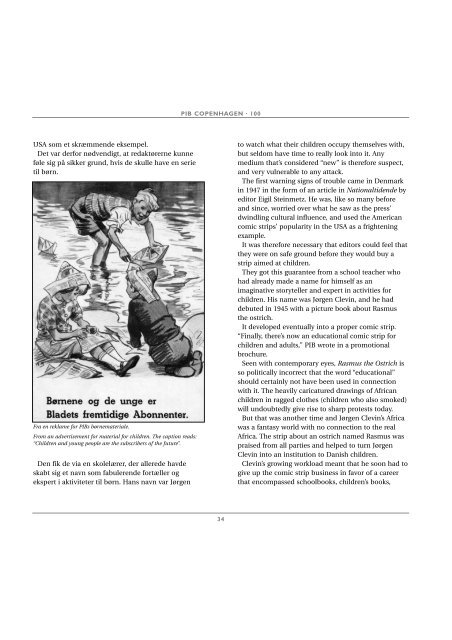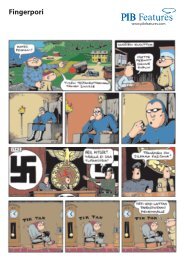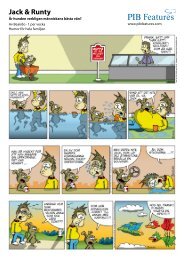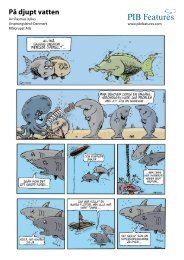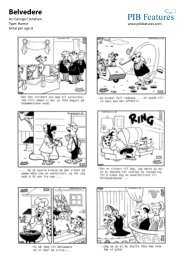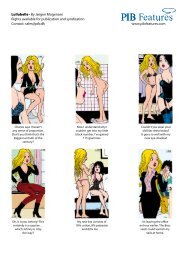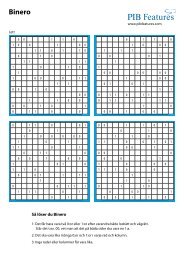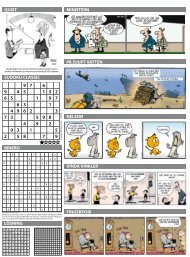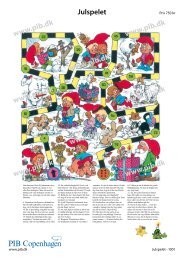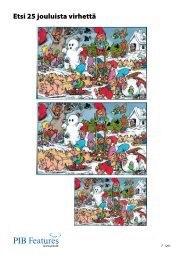PIB COPENHAGEN · 100 - PIB Copenhagen A/S
PIB COPENHAGEN · 100 - PIB Copenhagen A/S
PIB COPENHAGEN · 100 - PIB Copenhagen A/S
Create successful ePaper yourself
Turn your PDF publications into a flip-book with our unique Google optimized e-Paper software.
USA som et skræmmende eksempel.<br />
Det var derfor nødvendigt, at redaktørerne kunne<br />
føle sig på sikker grund, hvis de skulle have en serie<br />
til børn.<br />
Fra en reklame for <strong>PIB</strong>s børnemateriale.<br />
From an advertisement for material for children. The caption reads:<br />
“Children and young people are the subscribers of the future”.<br />
Den fik de via en skolelærer, der allerede havde<br />
skabt sig et navn som fabulerende fortæller og<br />
ekspert i aktiviteter til børn. Hans navn var Jørgen<br />
<strong>PIB</strong> <strong>COPENHAGEN</strong> <strong>·</strong> <strong>100</strong><br />
34<br />
to watch what their children occupy themselves with,<br />
but seldom have time to really look into it. Any<br />
medium that’s considered “new” is therefore suspect,<br />
and very vulnerable to any attack.<br />
The first warning signs of trouble came in Denmark<br />
in 1947 in the form of an article in Nationaltidende by<br />
editor Eigil Steinmetz. He was, like so many before<br />
and since, worried over what he saw as the press’<br />
dwindling cultural influence, and used the American<br />
comic strips’ popularity in the USA as a frightening<br />
example.<br />
It was therefore necessary that editors could feel that<br />
they were on safe ground before they would buy a<br />
strip aimed at children.<br />
They got this guarantee from a school teacher who<br />
had already made a name for himself as an<br />
imaginative storyteller and expert in activities for<br />
children. His name was Jørgen Clevin, and he had<br />
debuted in 1945 with a picture book about Rasmus<br />
the ostrich.<br />
It developed eventually into a proper comic strip.<br />
“Finally, there’s now an educational comic strip for<br />
children and adults,” <strong>PIB</strong> wrote in a promotional<br />
brochure.<br />
Seen with contemporary eyes, Rasmus the Ostrich is<br />
so politically incorrect that the word “educational”<br />
should certainly not have been used in connection<br />
with it. The heavily caricatured drawings of African<br />
children in ragged clothes (children who also smoked)<br />
will undoubtedly give rise to sharp protests today.<br />
But that was another time and Jørgen Clevin’s Africa<br />
was a fantasy world with no connection to the real<br />
Africa. The strip about an ostrich named Rasmus was<br />
praised from all parties and helped to turn Jørgen<br />
Clevin into an institution to Danish children.<br />
Clevin’s growing workload meant that he soon had to<br />
give up the comic strip business in favor of a career<br />
that encompassed schoolbooks, children’s books,


